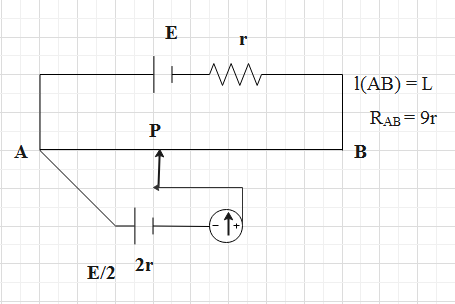
Galvanometer shows no deflection when length AP is

\[A.\,\dfrac{4L}{9}\]
\[B.\,\dfrac{5L}{9}\]
\[C.\,\dfrac{7L}{18}\]
\[D.\,\dfrac{11L}{18}\]

Answer
568.8k+ views
Hint: The galvanometer shows zero deflection when the resistances of on both the sides of the galvanometer are equal to each other. In other words, when no current passes through the galvanometer, it shows zero deflection. Firstly, we will compute the equivalent resistance value. Using this, we will compute the current through AB. Then, we will use the formula of the potential drop across line AP to find the value of the length AP.
Formula used:
\[I=\dfrac{V}{R}\]
\[V=I\times \rho l\]
Complete answer:
The galvanometer will show zero deflection, when, initially the rheostat will have zero resistance value. We will make use of Ohm’s formula.
Let us compute the equivalent resistance of the system. So, we have,
\[{{R}_{eq}}={{R}_{AB}}+r\]
Substitute the value of the resistance between the points A and B.
\[\begin{align}
& {{R}_{eq}}=9r+r \\
& \Rightarrow {{R}_{eq}}=10r \\
\end{align}\]
Thus, with the help of this value, we will compute the flow of current through line AB.
\[\begin{align}
& {{I}_{AB}}=\dfrac{V}{{{R}_{eq}}} \\
& \Rightarrow {{I}_{AB}}=\dfrac{E}{10r} \\
\end{align}\]
We have used E, in the place of voltage, as in the diagram its mentioned.
The amount of flow of current through the line AB is equal to the amount of flow of current through the line AP. So, the amount of flow of current through the line AP is,
\[{{I}_{AP}}=\dfrac{E}{10r}\]…… (1)
The potential drop across the line AP is given as follows.
\[{{V}_{AP}}={{I}_{AP}}\times \rho l\]
Where \[\rho \]is the resistance per unit length and l is the length of the line AP.
Here, the value of the resistance per unit length is \[\dfrac{9r}{L}\]. The potential drop across the line AP is given to be equal to \[\dfrac{E}{2}\].
Substitute these above values and the value of the equation (1) in the above equation of the potential drop.
\[\dfrac{E}{2}=\dfrac{E}{10r}\times \dfrac{9r}{L}\times {{l}_{AP}}\]
Continue further calculation.
\[\begin{align}
& \dfrac{1}{2}=\dfrac{1}{10}\times \dfrac{9}{L}\times {{l}_{AP}} \\
& \Rightarrow {{l}_{AP}}=\dfrac{5L}{9} \\
\end{align}\]
So, the correct answer is “Option B”.
Note:
In this question, we have made use of Ohm’s law equation, the formula of the potential drop. These two equations are the most important. While calculating the current through AB, we have used the complete potential value, whereas, while calculating the current through AP, we have used the half the value of the complete potential value.
Formula used:
\[I=\dfrac{V}{R}\]
\[V=I\times \rho l\]
Complete answer:
The galvanometer will show zero deflection, when, initially the rheostat will have zero resistance value. We will make use of Ohm’s formula.
Let us compute the equivalent resistance of the system. So, we have,
\[{{R}_{eq}}={{R}_{AB}}+r\]
Substitute the value of the resistance between the points A and B.
\[\begin{align}
& {{R}_{eq}}=9r+r \\
& \Rightarrow {{R}_{eq}}=10r \\
\end{align}\]
Thus, with the help of this value, we will compute the flow of current through line AB.
\[\begin{align}
& {{I}_{AB}}=\dfrac{V}{{{R}_{eq}}} \\
& \Rightarrow {{I}_{AB}}=\dfrac{E}{10r} \\
\end{align}\]
We have used E, in the place of voltage, as in the diagram its mentioned.
The amount of flow of current through the line AB is equal to the amount of flow of current through the line AP. So, the amount of flow of current through the line AP is,
\[{{I}_{AP}}=\dfrac{E}{10r}\]…… (1)
The potential drop across the line AP is given as follows.
\[{{V}_{AP}}={{I}_{AP}}\times \rho l\]
Where \[\rho \]is the resistance per unit length and l is the length of the line AP.
Here, the value of the resistance per unit length is \[\dfrac{9r}{L}\]. The potential drop across the line AP is given to be equal to \[\dfrac{E}{2}\].
Substitute these above values and the value of the equation (1) in the above equation of the potential drop.
\[\dfrac{E}{2}=\dfrac{E}{10r}\times \dfrac{9r}{L}\times {{l}_{AP}}\]
Continue further calculation.
\[\begin{align}
& \dfrac{1}{2}=\dfrac{1}{10}\times \dfrac{9}{L}\times {{l}_{AP}} \\
& \Rightarrow {{l}_{AP}}=\dfrac{5L}{9} \\
\end{align}\]
So, the correct answer is “Option B”.
Note:
In this question, we have made use of Ohm’s law equation, the formula of the potential drop. These two equations are the most important. While calculating the current through AB, we have used the complete potential value, whereas, while calculating the current through AP, we have used the half the value of the complete potential value.
Recently Updated Pages
A man running at a speed 5 ms is viewed in the side class 12 physics CBSE

The number of solutions in x in 02pi for which sqrt class 12 maths CBSE

State and explain Hardy Weinbergs Principle class 12 biology CBSE

Write any two methods of preparation of phenol Give class 12 chemistry CBSE

Which of the following statements is wrong a Amnion class 12 biology CBSE

Differentiate between action potential and resting class 12 biology CBSE

Trending doubts
What are the major means of transport Explain each class 12 social science CBSE

Which are the Top 10 Largest Countries of the World?

Draw a labelled sketch of the human eye class 12 physics CBSE

Explain sex determination in humans with line diag class 12 biology CBSE

Explain sex determination in humans with the help of class 12 biology CBSE

Differentiate between homogeneous and heterogeneous class 12 chemistry CBSE




